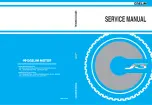
15 ELECTRICAL SYSTEM
74
V01273-11
–
Position negative cable
4
and mount and tighten the screw.
Finishing work
–
Mount the front rider's seat. (
–
Mount the passenger seat. (
–
Set the clock. (
15.3
Charging the 12-V battery
Warning
Risk of injury
Battery acid and battery gases cause serious chemical burns.
–
Keep 12 V batteries out of the reach of children.
–
Wear suitable protective clothing and safety glasses.
–
Avoid contact with battery acid and battery gases.
–
Keep sparks or open flames away from the 12 V battery.
–
Only charge 12 V batteries in well-ventilated rooms.
–
Rinse the affected area immediately with plenty of water in the event of contact with the skin.
–
Rinse eyes with water for at least 15 minutes and consult a doctor immediately if battery acid and
battery gases get into the eyes.
Note
Environmental hazard
12 V batteries contain environmentally hazardous materials.
–
Do not dispose of 12 V batteries as household waste.
–
Dispose of 12 V batteries at a collection point for used batteries.
Info
Even when there is no load on the 12-V battery, it discharges steadily each day.
The charging level and the method of charging are very important for the service life of the 12-V battery.
Rapid recharging with a high charging current shortens the service life of the battery.
If the charging current, charging voltage, or charging time is exceeded, electrolyte escapes through the
safety valves. This reduces the capacity of the 12-V battery.
If the 12-V battery is depleted by repeated starting, the 12-V battery must be charged immediately.
If the 12-V battery is left in a discharged state for an extended period, it will become deeply discharged
and sulfating occurs, destroying the battery.
The 12-V battery is maintenance-free. The acid level does not have to be checked.
Preparatory work
–
Remove the passenger seat. (
–
Remove the front rider's seat. (
–
Disconnect negative cable of the 12-V battery to avoid damage
to the onboard electronics.















































